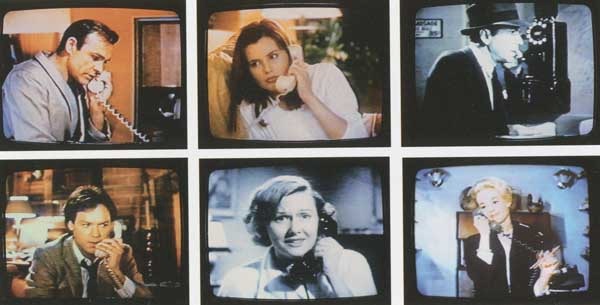
Christian Marclay
Swiss-American, 1955 -
Telephones, 1995
video transferred to DVD, edition 182/250, 7:30 minutes
SBMA, Museum purchase, General Art Acquisitions Fund

Christian Marclay, flickr.com
"These things I sample, or clip, are things that we share - music, films, sounds. It triggers a layer of participation from the audience as they recognize the material and remember it." - Christian Marclay
COMMENTS
Telephones begins with a series of scenes of people dialing phones. Suspense builds as the mostly silent clips segue into others that feature ringing phones. Soon, people who appear on the screen are answering phones in a volley of hellos. An exchange starts, which becomes farcical as it progresses from one caller, each in a different movie, to another. A succession of quiet scenes showing conversants listening ensues. One at a time, the callers hang up, and the rhythm of their clicking receivers is interrupted by a scene of a woman (the actress Barbara Stanwyck) standing in a phone booth who, seemingly miffed, looks at the receiver in her hand before returning it to its cradle.
Knitted together, these snippets of filmed, fictional phone calls create a macronarrative: a single, epic call, the arc of which mimics that of the scenes that comprise it. In this way the montage inflates the drama of movie phone calls and real life ones, too.
Just as viewers recognize in Telephones the actions involved in making and receiving phone calls, most people who see the video likely also recognize scenes from classic movies that are featured. In this way, Marclay’s sampling of movies compares to his earlier music mixing and other artists’ musical sampling; DJs can hook listeners with familiar riffs much in the same way that a scene in Marclay’s video might catch a viewer’s eye. And like a talented DJ can lull a listener into a reverie, Telephones can mesmerize those who watch it.
- Zoe Larkins, Christian Marclay's Telephones Video Ringing at the Denver Art Museum, May 7, 2015
http://denverartmuseum.org/article/telephones-video-ringing-denver-art-museum
SBMA CURATORIAL LABELS
Christian Marclay’s Telephones (1995) is recognized as a landmark in the history of video art. Using dozens of masterfully edited clips from movies and television shows, Marclay constructs an intricately paced sequence of people dialing, answering, talking on, listening to and hanging up various kinds of telephones, all from the pre-smart phone era.
With its constantly changing cast of characters, moods, settings, and time periods, this widely exhibited and acclaimed video immediately engages us as viewers and suggests any number of narrative possibilities. In this way Telephones represents many important ideas found in postmodern art and culture of the past fifty years. These include the idea that in our media-dominated age artists look to popular culture rather than nature for the raw material of their work; that images subtly or overtly influence how we process our interior lives and interpret the outside world; and that film is uniquely capable of transmitting human emotions we instantly recognize, and then somehow cannot help but feel ourselves.
Created in 1995, Telephones is a precursor to Marclay’s renowned film installation The Clock (2010), which similarly uses television and movie clips to create a 24-hour projection that acts as a real-time clock for its viewers. The Santa Barbara Museum of Art’s acquisition of Telephones offers visitors a primer on Marclay’s distinctive style, and represents the Department of Photography and New Media’s most recent addition to its growing collection of works involving moving images, sound, and other forms of electronic expression.
- Von Romberg Gallery, December, 2016
